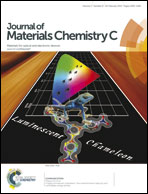Graphene nanoribbons generate a strong third-order nonlinear optical response upon intercalating hexagonal boron nitride†
Abstract
An artificial hybrid structure (named as BCNNRs) was designed by inserting wide-gap hexagonal boron nitride (h-BN) nanoribbon in between zero-gap graphene nanoribbon. Third-order nonlinear optical properties of this hybrid structure were calculated by employing the time-dependent density functional theory combined with sum-over-states method. Our calculations reveal that, distinct from individual BN nanoribbons or graphene nanoribbons, the hybrid BCNNRs exhibit a much stronger third-order nonlinear optical response. A giant third-order NLO susceptibility χ(3) of 1 × 10−4 esu is predicted, almost three orders of magnitude larger than that recently experimentally measured for graphene. Furthermore, a maximum third-order non-linear optical response of BCNNRs is obtained by adjusting the size of h-BN nanoribbons. The strong third-order non-linear optical response predicted for BCNNRs originates from the charge redistribution in graphene nanoribbon as h-BN ribbon is inserted. The results reported in this work show that insertion of a wide-gap semiconductor h-BN nanoribbon in zero-gap graphene can give rise to a strong three-order nonlinear optical response, which may guide the future development of structural design and exploration of more advanced nonlinear optical materials.


 Please wait while we load your content...
Please wait while we load your content...